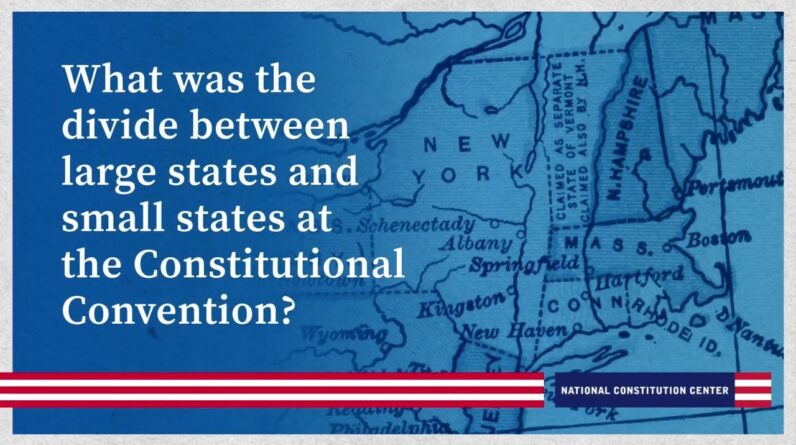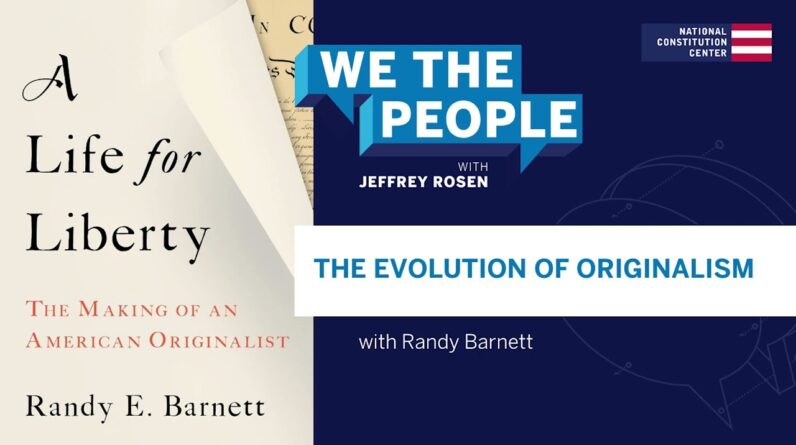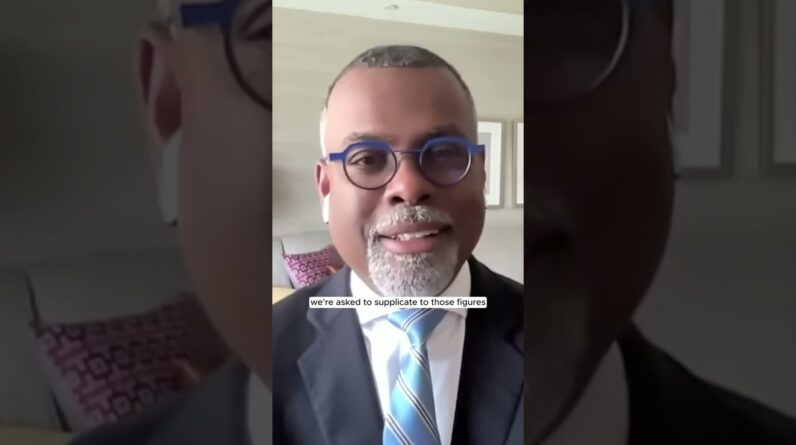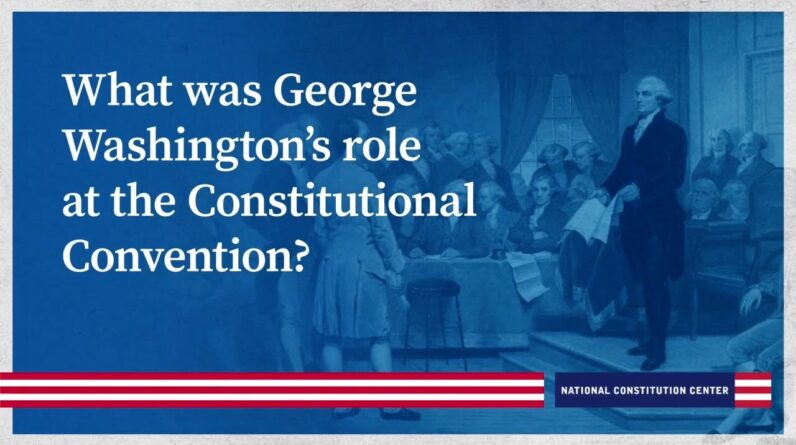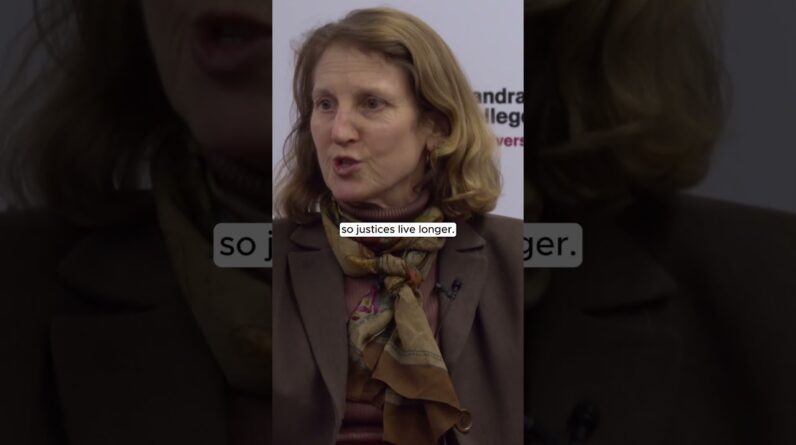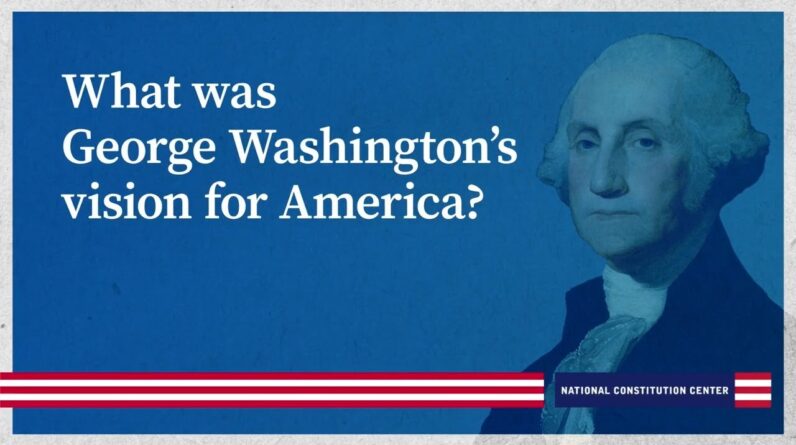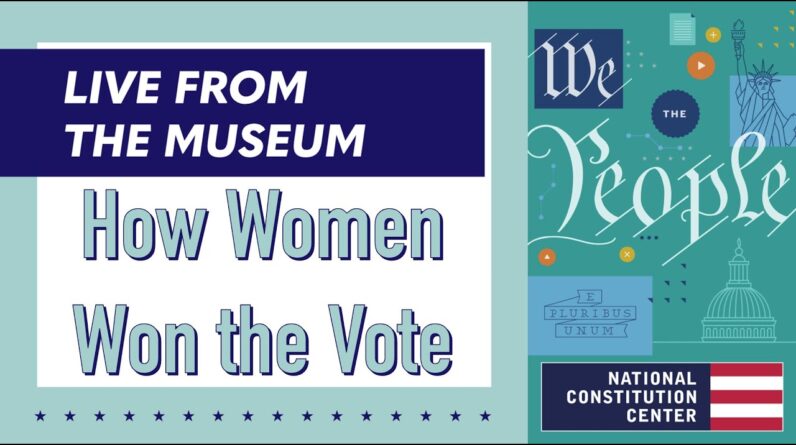
A National Constitution Center museum educator will lead virtual audiences on a live guided tour of our exhibit that traces the triumphs and struggles that led to the ratification of the 19th Amendment. The tour will help students to better understand the long fight for women’s suffrage, and will also highlight some of the many women who transformed constitutional history—including Elizabeth Cady Stanton, Alice Paul, and Ida B. Wells. Plus, students will get an up-close look at some of the one-of-a-kind artifacts on display, including a rare printing of the Declaration of Sentiments from the nation’s first women’s rights convention in Seneca Falls, a ballot box used to collect women’s votes in the late 1800s, Pennsylvania’s ratification copy of the 19th Amendment, as well as visually compelling “Votes for Women” ephemera.
Register for upcoming programs: https://constitutioncenter.org/news-debate/americas-town-hall-programs
Visit our media library to discover more online classes, podcasts, and Town Hall conversations: https://constitutioncenter.org/news-debate/media-library
Subscribe to the National Constitution Center on YouTube: https://www.youtube.com/user/ConstitutionCenter?sub_confirmation=1
Follow the National Constitution Center on social media!
Facebook: https://www.facebook.com/constitutionctr/
Twitter: https://twitter.com/ConstitutionCtr
Instagram: https://www.instagram.com/constitutionctr/
Sign up for our newsletter: https://visitor.r20.constantcontact.com/manage/optin?v=001isJLcA0NBDU2D_HGg2ohDtUUbfEfE-Gpl9t1—7rRBAsT4f5B7IV2UbsNZFPIVvYFY1ZtLK4zENNfTuda3Z_WJBoefPS8mnvM8KMyfAOq4%3D
Folks for joining us welcome from the National Constitution Center my name is Brian uh we are joined as well by our Friend uh Sydney uh in the exhibit she's Currently in the 19th Amendment how Women won the vote the exhibit opened in 2020 here at the national Constitution Center it was a really fantastic one to Explore this month March which is of Course women's history month and so we Thought this was a really fantastic talk To have with all of you folks so please S take it away thank you so much thanks Brian and welcome everyone my name is Sydney is Brian noted before and I'm an Educator here at the Museum and right Now I'm standing in our 19th Amendment Exhibit how women won the vote so just To knowe before we get started this Exhibit pretty much goes in a timeline And it really makes up a broad timeline Of diverse women who went through trials And triumphs to get the right to vote Right along with all other rights and We're getting in and get into that as we Move through the exhibit before we start To move though I do want to note that We'll see prominent colors of green Purple white and gold and those are the Colors of the suffrage movement here in The United States we used the colors Purple gold and white which was Influenced from Great Britain the Suffragettes in Great Britain whose
Colors were green white and purple we Only swapped the color green with gold Because the sunflower ALS represents um The suffrage movement here in the United States so you'll see a lot of that Imagery as we move throughout the Exhibit so let's get started into our Timeline and really see how these Suffragists fought for the right to vote As well as all other Rights so we start in the 1800s in the year 1840 Specifically two suffragists named Lucrecia M and Elizabeth Katie Stanton They attended a anti-slavery convention In London as I mentioned before is the Year in the year 1840 and at the convention they actually Were refused to be seated um solely off The fact that they were women so they Knew that once they returned to the United States that they had to fight out Against this Injustice that women were Facing so in the year 1848 both luri M and Elizabeth Katie Stanton organized a convention in senal Falls New York there at the convention They composed a declaration of Sentiments which directly reflected the Declaration of Independence it spoke out Against equalities that they didn't have Um it spoke out against all other rights That they wanted and needed um and just Basic human rights right so we focused a
Lot about the right to vote in this Exhibit however the right to vote was Just one out of the many other demands That they needed or wanted during this Time they also believed that the right To vote was the key to securing all Other rights so all in all the Declaration of Independence ended with 16 demands and we're actually going to Zoom in to some of these demands that They wanted or requested um within the Declaration of Sentiments so we have a Lot here but just to name a few they Were asking for basic things right um Such as equal education the right to own Property or land right equal wages or Equal pay so we'll pan this wall here so You all can read up on um some of these Demands that they were asking For while you all are reading um I'll Continue on to note that the suffrage Movement really emerged through Abolitionist circles throughout the United States um specifically the Northeast area of the United States During this time there was Unity between White women women of color um and they Really all had one Focus Focus right one Purpose during this part of the Timeline so you also see uh having Deprived of her of this first right of a Citizen the elective franchise thereby Leaving her without representation in The halls of legislation um he is
Supressed her on all sides um and that Was demand number four I think one that Always stands out to So we can see during this time or I will Note just as a sidebar that during this Time women use Outlets such as news Coverage um using the Press um also Using different ways through court Systems and we'll get into that in a Little bit but we'll see how that also Changes as we move throughout the Exhibit so this is 1848 in this part of the timeline we're Moving into the 18 1860s um also diving into the Civil War So as we know in the 1860s the United States underwent the Civil War um Following the Civil War once it Concluded and before I get to that sorry I do want to note that during the Civil War the suffrage movement was put on Pause to focus on war efforts and what Was going on within the United States During this Time once the Civil War was concluded The 13th Amendment followed which Abolished slavery and then the 14th Amendment followed after that which Granted citizenship to all persons born Or naturalized within the United States And we'll get to why that's super Significant in just a Moment so as you make our way I love Passing by this Dynamic wall um I think
It's so interesting because it shows um Two different sides of an Image So we've already established that women In the United States had very little Rights within the United States right Including the right to vote but many Other rights as Well however during this time as you Move through the 1860s some women were allowed to vote in Smaller elections right such as local Elections they still weren't able to Vote nationally as yet so you can see a Bunch of different voting ballots Here along this wall different Experiences of women who attempted to Vote right you had women such as Susan B Anthony who successfully registered to Vote in New York um however she was Caught and fined $100 but never Paid then you also had women who dressed Up in men's clothing right who used a Number of different tactics to try and Get their vote into the Ballots and then right behind me you can Also see one of my favorite artifacts in The museum I'll say but it is a Ballot Box specifically for women right so our Museum label actually notes Ballot Box For women's votes specifically um so Just to emphasize the fact that even if They did have a say or even if they did Um have this opportunity to cast a vote
They still had to keep their votes Separate right in a separate Ballot Box From men right or from other people I do want to note two different women Who really changed the course of how the Suffrage movement looked um and one of Those women we can see her portrait here Is Myra Bradwell Myra Bradwell argued in The court system claiming that the 14th Amendment protects her as a citizen Right so therefore she should have the Right to vote but not only that but she Also questioned the education system Right when it came to women so not only Should she have the right to vote but She should also have the right to Practice law which is something that she Wanted to Do on that wall there we also seen Virginia Miner so in Virginia Miner's Case she was rejected when going or Attempting to vote um and she also Argued in the court system that under The 14th Amendment she should be able to Vote right she should have this right to Vote however in both cases the court Ultimately ruled that yeah you are a Citizen However voting is not a right of Citizenship right it's not a privilege That comes with citizenship in Virginia Minor case specifically the courts Decided that they would leave full Suffrage up to the states so what did
This do for the suffrage movement right How do they move past this or move on From this here so we're going to move to The second section of our exhibit which Is title changing tactics and I think It's a perfect name or perfect Introduction to where we are in our Exhibit because within this time or During this time they really actually Did have to change your tactics in order To gain the vote so going back to Virginia Miner's case right where the Courts decided that we'll leave it up to The states to decide or to Grant full Suffrage so what the suffrages do they Decided that we will try state by state Right and Eventually hopefully the entire United States right would give women full Suffrage right on a national level Now so one of my favorite pieces um Right behind me it's titled The Awakening and in this map it shows the East Coast for those of us in the chat Or that are on this that are from the East Coast um you see that side in chaos Right you see people yearning for Something and reaching for something And then on the west side or on the west Coast if we have any West coasters in The chat today you see his peace Together right and more harmonized um You also see a vote for women Banner Right so what does this describe or what
Does this Explain it is important to note that the West Coast was the first to Grant full Suffrage more specifically Wyoming in The year 1869 Wyoming granted full Suffrage for women Um and the reason they did that was Because their population of women in Their state had been so low that they Needed a way to want or to make women Want to go to their state right to move To their state so they granted full Suffrage so you can see here just from Looking at this image or this Illustration alone that suffrage Expanded first in the West so that's not only one way that That women or suffrages change your Tactics around um during this movement They also change your tactics in their Approach as Well so we have a whole bunch of Artifacts behind me but artifacts that Really represent the way in which these Suffrages actually change your approach And change your tactics um becoming more Militant right using bold advertisement They use ordinary objects as symbols Right to really represent what they were Standing for um so you can and we'll pan These artifacts here you'll see teacups You'll see buttons and pins you'll see Penants sashes Posters um all of these different things
Right they use intentional propaganda Throughout their work and again they Were really trying to get their message Out to the public about what they wanted Right what their goal was and what they Were really fighting For so we seen the artifacts we know That their tactics had changed but there Was also something that really impacted The suffrage movement and one of those Things was the racial divide that Occurred um a little before this time But also existed during this time where We're standing right now in the exhibit So after the 15th Amendment and just to Note the 15th amendment allowed African-American men who were newly Freed um the right to vote so that was Something that caused a lot of tension Um and a lot of uh animosity right Within the suffrage movement when it Came to one side um focusing solely on The right to vote for women specifically And then one side of the suffragist Movement fighting for the right to vote But all these other rights as well right And not just for women um but women of Color African-American people um Etc And that takes us to this Portion takes us to this portion of our Exhibit um so in 1913 the First National Women's Suffrage March took place in Washington DC it was actually the day
Before President Wilson's Inauguration so I do want to zoom in on A special artifact that we have um which Is a Howard University sorority Alpha Kaa Alpha um Or their Authority was located on Howard University's campus and the president of Alpha Kappa Alpha actually wrote to Someone who was known as the president Of the women's suffrage movement at this Time Alice Paul she wrote a letter Stating that we want to be a part of This March right we also want to fight And March for women's suffrage however We don't want to if we'll be met with Discrimination and racism during the March Um even after that request the suffrage Movement wrote back or the national Suffrage association wrote back um Pretty much stating that we can't grant That right so keeping that separation Between people of color black women Versus um white women at in the suffrage Movement um they really did that to Establish or to Grant other white Counterparts support right so they were Looking for that support and this was One means of doing that right it was Keeping that movement Separate however we had women such as Idb Wells who did in fact come in to the March um and started off in the back of The March but then eventually in idb
Wells case specifically and eventually Joined her Illinois delegation at the Front of the March eventually chaos and Violence erupted at the March and now President Wilson's inauguration um was Sharing headlines with the suffrage Movement in Washington DC so a Monumental Moment so as we're transitioning to the Next section of the exhibit I do want to Note that there were anti-suffragists Right who organized and also rallied Also created um bold advertisement right PIR and sashes um and a lot of their Arguments really revolved around the Point that if women got into politics if We gave them the right to vote then they Would stray further away from their Families their morals and the household Um they also believe that granting women Full suffrage or focusing on this cause Would enfranchise black women when it Came to voting Rights so we're stepping into another Area um of our exhibit but also Another uh time right so we're moved Through this relatively quickly but we Have to understand that as we're moving Through decades are passing so so much Time has gone by from where we first Started in 1848 to where we are now in The 1900s so you can see here winning the Vote but how did they get there right
How did they actually win the vote and This section to take us into That so we're now in around 1917 1916 1917 and there were a group of women Suffragists who were known as a silent Sentinels and the silent Sentinels Picketed in front of the White House um Actually went for over a year um Peacefully I do want to note they held Up banners they held up signs they Actually burned some of President Wilson's speeches um in front of the White House so still in this moment They're I'm taking taking a more Militant approach right they're actually Taking things to the streets they're Protesting in public boldly however They're doing so Peacefully though they were Peaceful um in demonstrating they were Still arrested right and the cause for Their arrest was obstructing traffic um Even though they weren't really Obstructing traffic right um during this Time I do want to know as they're Picking there's a lot of pedestrians That are passing by that are angry um But they sit out there right they even Sit out there through bad weather um and Again just to emphasize um they did all Of this and they organized peacefully They also were just exercising their First amendment rights right um but they Were still arrested and placed in a
Workhouse Prison um so you can see that right Behind me um but just to note that in The workhouse prison conditions were Hard um the food was infested um there Was abuse physically and verbally so the Conditions were really bad they went on Hunger strikes within the workhouse Prison um but then they were um forced Into being fed um so the conditions were Um Terrible so we're approaching the end of Our exhibit but I do want to show one Artifact um because I think it really Does put things into perspective at this Point in the exhibit so it says as a war Measure right 4 months later or four Months After um the picketing of the White House or four months after yeah the Silent Sentinels the United States went Into World War I um so that changed the Course of things drastically right Because men were going out to fight Within the war and women stayed behind Right so in this list you can see the Country is asking of women's service Farmers mechanics nurses bellboys Army Cooks they were working in factories as We can see in some of these Images and then on the opposite side it Says women are asking of the country INF Franchisement so and then are the women Going to get it I do want to note right
On the flip side decades ago women Weren't even allowed to be in these Spaces right they weren't even allowed To be taking on these tasks to work in Factories to be Bell boys and Etc but Now the country needed that from women So that put a lot of pressure on President Wilson right because women Were upkeeping and supporting the Country showing their loyalty to Democracy and they were asking for one Thing and that was the vote so it put a Lot of pressure on President Wilson During this time I do want to note that An official or a national Amendment for Women's suffrage was put into Congress Or proposed into Congress decades ago Right in the 1870s we're now in the mid1 1900s right So 1920s just about in the year 1918 um the house passed then what will Be the 19th Amendment but um full Suffrage for women but it fell short in The Senate um so by midterm elections Women were back out rallying going state By state using that approach again um to Really gar this Vote then um let me go back a little bit So they're really trying to Garner this Vote then the house passed for full Suffrage again in the year 19 1919 and then the house and the Senate Both
Approved sorry trying to make that as Simple as Possible and they both approved however The amendment still had to be ratified By 36 States total you can see these Women here sewing Stars onto the flag um That really represented those 36 states That they needed in order for this Amendment to be put into Place ratified and amended into the Constitution so it was up to one state And technically one person that state Was Tennessee and that person was Harry T burn now Harry T burn had the Intention of voting no for full suffrage Um when walking into this area um However he pulled out a note from his Mother um we can actually probably zoom In on it a little bit um it's pretty Small so you may not be able to uh Decipher the dialogue that's written on There but just one quote that she Mentioned was be a good boy and vote for Women's suffrage so in that very moment Harry T bur changed his vote from no to Yes for full suffrage um and the crowd Erupted into chairs and the 19th Amendment was put in place um and full Suffrage was granted for Women so in the year 1920 now um many Women attended the ballots they voted Placed their votes they now had this Right right except for some women women Of color black women they still face
Discrimination at the ballots right so They had to go through things such as po Taxes they had to face literacy Tests um so their fight wasn't over Right they still had to really overcome Um a lot of what they were fighting for In the very beginning even though women Had this vote so the 19th Amendment Protected um your right to vote as far As gender um but race was still a factor And a barrier at the voting Ballots so we're approaching the very End of our exhibit we have the Equal Rights Amendment and we'll actually just Zoom into this map because I think it's So important to see the dates um Especially for um States like Virginia If we have any Virginia people in the Chat um where they ratify this amendment In 2020 but what was the Equal Rights Amendment the Equal Rights Amendment was Proposed by Alice Paul and it was really To secure all other rights beyond the Vote right so um within the workforce Within the education system and Etc so That's what the Equal Rights Amendment Aimed for um however it sort of fell Through and we can see from these Questions if we want to zoom in and I Want us all to really think about these Questions as we close out this tour as Well um there were some states who Rescinded their approvals um there was Also deadlines right that were put in
Place um when it came to ratifying this Amendment so it leads us with these Questions can Congress impose a deadline If the time limit is valid can Congress Extend that deadline or can a state Resend its ratification should that be a Thing that's Possible so we have reached the end of Our 19th Amendment tour um I do want to Say that it was an extremely long Journey right an extremely long fight um I did this tour in roughly 30 minutes However it was decades um roughly 70 Years close to a century um before the 19th amendment was put in place before Women were granted that right to vote um But I want to thank you all so much for Joining us here today I'm going to hand It back over to our friend Brian to Close this out also if you all have any Questions I'll remain here we can see What you all add into the chat thank you All so much again for joining us here at The national Constitution Center
